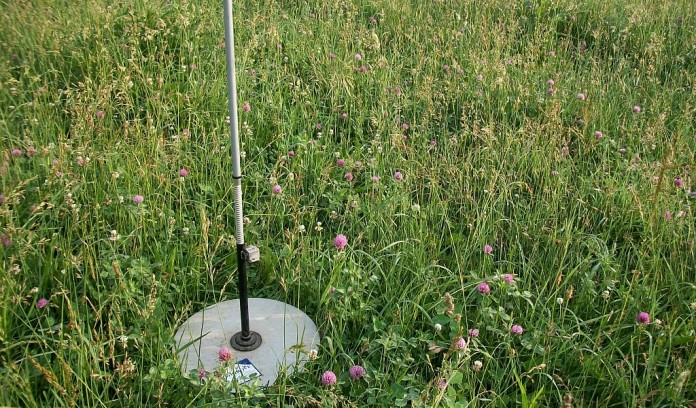
The time to frost seed in Ohio has come and gone for this spring. However, if you frost seeded earlier this year, those acts and what you do within the next two to three months will influence the success of your efforts. Frost seeding has been promoted as an economical way to increase the proportion of legumes in a forage stand, and it is — when done correctly.
Spur-of-the-moment decisions to broadcast red clover seed the first week of March and expect to see a lot of new legume plants throughout the stand in June is probably doomed for failure. A few plants will germinate and establish, but overall the seeding will not develop as a producer might think it should.
Increasing legumes to 35 percent of the plant population in a field is a good goal. If this level is achieved, legume plants will provide enough nitrogen for the grass plants to successfully grow and no additional nitrogen application should be necessary. However, good legume establishment from frost seeding is not as easy as it may sound. It takes more than just broadcasting seed at the beginning of the growing season to accomplish the goal.
Increase the odds
Planning and preparation are the first ingredients for success. Determining why no legumes, or less than the amount desired, are growing in your field is a great first step.
Is there a pH problem that needs fixed? Are nutrients in the soil available, in sufficient quantities, to provide new forage plants an opportunity to grow and thrive? A soil test generally costs less than $15 and provides information necessary to make good decisions regarding your soil’s fertility. Adding more seed to infertile ground or low pH soil will not increase legume plant numbers in your stand.
Nutrient levels in the soil and the amount of nutrients one should add, if any, for optimum plant growth, is indicated on the laboratory analysis.
If the soil pH is 6.2 or less, a lime application will probably be recommended to increase, or at least maintain, that pH level. Increasing soil pH takes time (often six to 12 months) after a lime application, so taking a soil test and making needed adjustments well in advance of a frost seeding date is recommended. If a soil test came back and it showed no additional nutrients were needed for the clover you intend to broadcast, that’s great.
Improving seedbed
Your next step should have been to make sure areas where frost seeding was done had little or no existing plant material left on the soil surface. The area should have been grazed tight late in the season, mown closely or used livestock to trample the area and expose some soil prior to seeding.
This would provide conditions for better seed to soil contact, in conjunction with several freeze and thaw events, to get good stand establishment.
Frost seed failures often occur if the seeding was done just before a heavy rain event or if several inches of snow covered the ground at time of seed application. Much of the seed may have been lost/washed away before embedding in the soil.
Seed quality
Poor quality seed, not having a high percentage of “pure live seed” (percentage is listed on the seed label) or not broadcasting enough seed are more reasons for frost seeding failures.
There are many high quality, hardy, new varieties of seed available on the market today. Some have been designed specifically for use in grazing situations and have much higher yield potentials than many of the old varieties.
Whatever legume seed is used, it should always be inoculated with the proper live bacterium inoculant for good growth. Many legume seeds today are pre-inoculated, but improper storage or seed that is too old may cause the bacteria to dry out and die. This can cause failure of legume establishment.
Finally, as growth begins here in the spring, new legume seedlings will have a better chance to start if they have help competing against the established plants.
Frost seeded pastures should be grazed lightly or clipped in the spring at regular intervals when grass plants are approximately 8 inches in height. This will allow sunlight to enter the canopy so new legume seedlings are not shaded out.
Don’t overgraze
However, do not allow animals to graze seeded areas so heavily (to heights less than 3 inches) that they ruin the new seeding before adequate roots are developed.
Temporary electric fence may be needed to control livestock and prevent overgrazing. Strict grazing management to allow plants an adequate rest period after each grazing pass must be implemented to produce strong root systems and maintain healthy plant growth. If continuous unmanaged grazing is allowed to occur, your frost seeding efforts will be pointless.
In hayfields
If frost seedings were made in hay fields, do not apply high rates of nitrogen fertilizer to first cutting hay. Established grass plants, in mixed grass/legume stands, will out-compete the newly seeded legume plants and shade them out.
Plan to make first cutting hay, on any frost seeded fields, early in the season (mid-May) if weather and field conditions permit. Grass height in second cutting hay will not be such a problem and new legume plants will be further development to compete better with the grasses.
Attention to details
There are many good reasons to use frost seeding techniques to increase legume proportions in your forages. Establishment of higher quality forage in undisturbed sod, reduced labor, less cash expense compared to conventional tillage methods and the ability to increase forage production with minimal equipment investment are just a few. However, do not let your frost seeding fail this spring because you don’t follow through with proper management of the new seeding.
Pay attention to the details, monitor the new growth and manage your frost seeding to get the full benefits this method has to offer.
—












